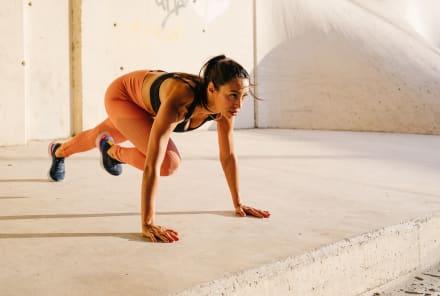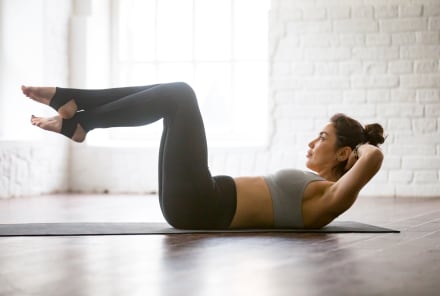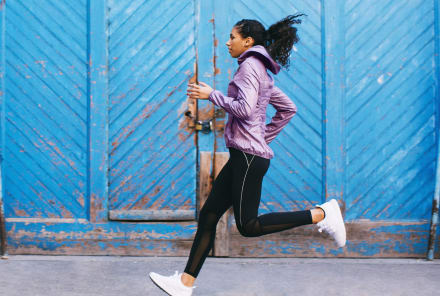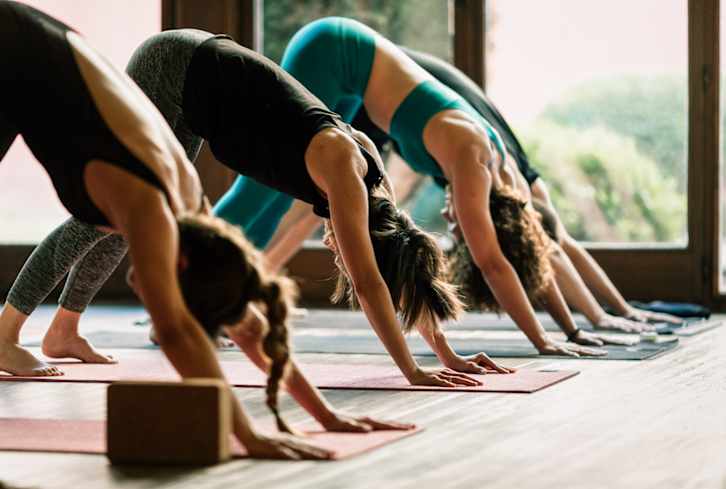Advertisement
Mobility, Recovery, & Stretching Practices That Keep Athletes In Top Shape


We live in a time of doing more, going bigger, lifting heavier. Gains feel great and reflect our progress, but much of the magic happens when we’re not doing the actual work. This is the realm of recovery.
Exercise is a form of good stress (also known as hormesis), and recovery allows us time to come back to balance. Muscles heal and grow, the nervous system regulates, inflammation subsides, and injury risk decreases.
Complementing hormesis with recovery means positive adaptation, equaling more strength, endurance, and speed—we get better at being better.
Meet the experts:
Nicole Haas, PT, DPT, OCS
Nicole Haas, PT, DPT, OCS is a physical therapist and founder of Boulder Physiolab in Colorado.
Rachelle Reed, PhD, ACSM-EP
Rachelle Reed, PhD, ACSM-EP is a Certified Exercise Physiologist.
Why women may want to approach recovery differently
Before diving into our expert-recommended tips and tricks for recovery, it’s worth exploring the ever-present role female hormones play in athletic performance and why women may benefit from a different approach than men.
Nicole Haas, PT, DPT, OCS, physical therapist and founder of Boulder Physiolab in Colorado, noted: “As a PT, I’m always looking at the female athlete in phases of cycles, whether it is for recovery or training,” she says. “I like to be mindful of the phase they are in, as it affects things like laxity and tissue tendon properties.”
These factors—as well as the link between increased estradiol and poorer neuromuscular control—may increase the risk of injury1 for women during the ovulatory phase.
It’s for reasons like these that many women have embraced cycle-syncing workouts, to move in accordance with their natural monthly rhythms. Training and recovery could both be customized to support this approach, with many women choosing gentler practices leading up to menstruation.
Certified Exercise Physiologist Rachelle Reed, PhD, ACSM-EP, offers another point of view, stating that not all women necessarily have to shift training and recovery according to their cycles, but that we should “customize to the individual. This means listening to our bodies, tracking symptoms, looking for patterns in energy levels, sleep, hunger and satiety, hydration needs, and adapting accordingly.”
Whatever method of monthly fitness you subscribe to, personalization never hurts. Embracing a few key recovery resources can help you discover how to perform at your personal best.
Cold water immersion
Chances are you’ve seen cold therapy at work—whether that’s an influencer enjoying their high-end cold plunge, the charge of jumping in a cold lake, or an athlete sitting in a garbage can of ice water.
Generally speaking, cold water immersion is intentional exposure to water colder than 60°F.
Evidence suggests that cold water immersion can:
- Decrease core body temperature, as well as tissue temperature
- Temporarily decrease pain and inflammation
- Impact blood flow on the skin and in the muscles
- Improve post-workout recovery and subsequent performance
- Temporarily increase epinephrine, norepinephrine, and dopamine
- Temporarily elevate mood
- Offer a short-term increase in metabolic rate as the body works to thermoregulate
Reed suggests starting with just 15-30 seconds of exposure, and gradually increasing 15 seconds at a time, slowly over several weeks. A general approach is to work towards 1 to 5 minutes, 2 to 4 times a week.
Many people embrace the full-body immersion in an ice tub (our editors love the Plunge), while others go with a more accessible cold shower. Just keep in mind that ice baths and cold plunges are often colder and provide more localized relief than a cold shower, while cold showers are more accessible.
Related reads: The best cold plunge tubs we tried & tested
Safety first:
Percussive therapy
Percussive therapy, which is now widely available in the form of massage guns, can be a valuable tool for recovery and getting your body back to a feel-good baseline. Massage guns use rapid vibrations and bursts of pressure to increase blood flow to certain areas.
These devices have been found3 to improve:
- Acute muscle strength
- Explosive muscle strength
- Flexibility
- Musculoskeletal pain
Massage guns can also help decrease tight muscle tissue and elongate muscle fibers. As an added bonus, they are a self-managed, affordable intervention compared to weekly massages.
Haas recommends the R1 from Roll Recovery for women, as it’s better for smaller bodies and provides the right amount of force. She suggests embracing portable interventions like this so people can address the negative impacts of sitting at a desk or in a car throughout the day.
Related read: How to relieve sore muscles after a taxing workout
Stretching & mobility support
When it comes to achieving peak performance—whether that’s running, weight lifting, cycling, Pilates, or simply wanting to run around with your kids or grandkids—mobility matters. This means you can effectively move through full ranges of motion, free from pain, and safely.
And mobility requires strength, flexibility, stability, and control.
There are active ways to improve mobility through things like yoga, tai chi, and qi gong for flexibility and balance, as well as specific stretches to target trouble spots.
When it comes to stretching, Reed explains there are two approaches.
- Active stretching/dynamic movements: These bring you through a range of motion. Often recommended before a workout.
- Passive stretching/static stretching: You hold different positions or poses for 10-30 seconds. Recommended for post-workout or as a standalone.
Haas cautions that if you’re constantly stretching and noticing no difference, there are deeper issues to address—so you may want to seek professional help.
Myofascial release
One of Hass’ favorite approaches to both mobility and recovery is myofascial release, a technique used to release tension in the web of fascial tissues that are woven throughout the entire body. Stiff areas of fascial tissue are called trigger points, which is what you feel when you have a “knot” in a muscle.
For professional care, someone trained in myofascial release therapy can locate those trigger points and use slow, repetitive pressure to release tension and lengthen the tissue.
At home, you can use foam rollers, lacrosse balls, and fascial release sticks to find those tough spots and slowly work on releasing them, which have been linked4 to increased range of motion, reduced muscle soreness after exercise, and muscle performance.
This is a great opportunity to listen to your body and feel where it needs attention, which may change day-to-day and depending on your activities.
Make recovery a lifestyle
The body can’t function at its highest degree without the right inputs, so while these components might seem like the most basic, they’re actually the most important. Solid lifestyle habits should be the most consistent areas of recovery for everyone.
Sleep
- Allows the heart and nervous system to rest while cells and tissues repair.
- Human growth hormone is released, which promotes tissue healing, collagen synthesis5, and muscle growth.
- Athletes who sleep less than 8 hours a night are more likely to get injured and have less endurance.
- Many experts believe athletes in training need more sleep, perhaps an hour more a night, with studies showing increased speed, accuracy, and performance with consistent additional sleep.
- It’s safe to assume active people should strive for 8 or more hours each night, and check in with their level of energy in the morning.
Nutrition
- During exercise, our muscles use glycogen stores for energy, and can also break down muscle proteins.
- Eating carbohydrates post-workout maximizes glycogen replenishment6 for tissue repair and adaptation. Adding protein to carbohydrates post-workout enhances glycogen storage and reduces muscle damage6.
- Exercise psychologist Stacy Sims, MSC, PHD, recommends women eat 30-45 minutes post-workout to maximize these processes, thanks to increased insulin sensitivity (while men have a larger 3-hour window).
- Researchers recommend7 aiming for about 1.6 to up to 2.2 grams of protein per kilogram of body weight daily for muscle protein synthesis. You can think of this as striving for one gram of protein per pound of body weight to reach the higher end of that range.
- Leucine is an especially important amino acid for muscle protein synthesis, with 2.5 grams per serving of protein being the minimal amount for efficacy (which comes from around 30 grams of complete protein, most easily found in animal sources).
Hydration
- Water is essential for cushioning joints, proper muscle function, breathing, energy, and concentration—all major components of optimal performance.
- When we sweat, we lose water plus electrolytes like magnesium, potassium, chloride, calcium, and sodium, which impact how the body retains water and nerve and muscle function.
- Electrolyte drinks and mixes may be helpful for some very active people, but beware of added sugar, and those with high blood pressure and kidney problems should consult a doctor first.
- Adults should drink 6 to 12 ounces of water for every 20 minutes of activity during activity, and 16 to 24 ounces afterwards.
- Water-rich foods are a great idea, like cucumbers, watermelon, and citrus.
Recovery doesn’t have to be complicated. These lifestyle habits set you up for your best daily performance, athletic performance, and a faster time bouncing back so you can keep doing what you love (and getting better at it).
The takeaway
Recovery practices are integral in every fitness routine, whether that means a fancy cold plunge, a foam roller at home, or dialing in optimal protein intake. Basic daily lifestyle principles should be kept consistent for peak performance and women may benefit from extra mindfulness around their cycles and nutritional needs.
7 Sources
- https://pubmed.ncbi.nlm.nih.gov/36833966/
- https://pubmed.ncbi.nlm.nih.gov/38271095/
- https://www.ncbi.nlm.nih.gov/pmc/articles/PMC10069390/
- https://www.ncbi.nlm.nih.gov/pmc/articles/PMC4637917/
- https://www.ncbi.nlm.nih.gov/pmc/articles/PMC2821728/#:~:text=PMID%3A%2019933753-,Growth%20hormone%20stimulates%20the%20collagen%20synthesis%20in%20human%20tendon%20and,without%20affecting%20myofibrillar%20protein%20synthesis
- https://www.ncbi.nlm.nih.gov/pmc/articles/PMC3905295/
- https://pubmed.ncbi.nlm.nih.gov/29497353/

Short On Time? Try This Personal Trainer's 5-Minute Full-Body Workout
Krista Stryker, NSCA-CPT

Short On Time? Try This Personal Trainer's 5-Minute Full-Body Workout
Krista Stryker, NSCA-CPT

Short On Time? Try This Personal Trainer's 5-Minute Full-Body Workout
Krista Stryker, NSCA-CPT

Short On Time? Try This Personal Trainer's 5-Minute Full-Body Workout
Krista Stryker, NSCA-CPT









